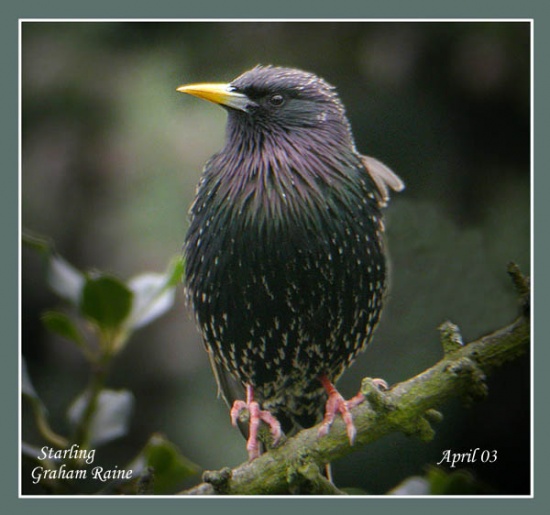Alternative name: European Starling

- Sturnus vulgaris
Identification
L. 20-22cm Wide variation in plumage. Both sexes are similar, although the female is less glossy than the male
Non-breeding
- Glossed black with a purple and green shine
- Tips of the body feathers have large white spots
- Dark bill
- Brown legs
With wear, the white spots are lost, while the bill and legs turn yellow.
Breeding
- Adults glossy-black without any spots
- Young birds are dull grey-brown
Variation
Some of the eastern subspecies are completely spotless, and may show a violet gloss.
Distribution
This starling is native to most of Eurasia, but has been introduced to South Africa, North America, Australia and New Zealand.
Taxonomy
Polytypic. Consists of twelve subspecies.
Subspecies[1]
- S. v. granti:
- S. v. vulgaris:
- Canary Islands and Iceland to Ural Mountains, northern Ukraine and south-eastern Europe
- S. v. faroensis:
- S. v. zetlandicus:
- S. v. tauricus:
- S. v. purpurascens:
- Western Transcaucasia to Georgia and Armenia
- S. v. caucasicus:
- S. v. nobilior:
- Afghanistan, Transcaspia and Khorasan
- S. v. poltaratskyi:
- Eastern Ural Mountains to Lake Baikal, Kazakstan and western Mongolia
- S. v. porphyronotus:
- Southern Dzungaria and Tien Shan Mountains to Pamir Mountains and Samarkand
- S. v. humii:
- Western Himalayas (Kashmir to Garhwal)
- S. v. minor:
- Locally in western Pakistan (Sind)
Habitat
Varied. Can be found in any reasonably open environment from farmland to salt marsh.
Behaviour
Starlings walk rather than hop. Their flight is quite strong and direct; they look triangular-winged and short-tailed in flight.
Very gregarious out of the breeding season.
Breeding
Nests in thatches, nest boxes, tree holes.
Diet
They mainly feed on insect larvae but are opportunist feeders and will visit bird tables. They also like autum berries.
Vocalisation
<flashmp3>Sturnus vulgaris (song).mp3</flashmp3>
Listen in an external program
References
- Clements, JF. 2008. The Clements Checklist of Birds of the World. 6th ed., with updates to December 2008. Ithaca: Cornell Univ. Press. ISBN 978-0801445019.
Recommended Citation
- BirdForum Opus contributors. (2024) Common Starling. In: BirdForum, the forum for wild birds and birding. Retrieved 23 April 2024 from https://www.birdforum.net/opus/Common_Starling
External Links
For videos of Starling Roosts





